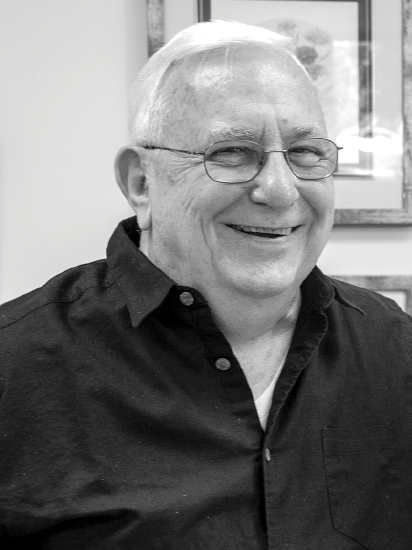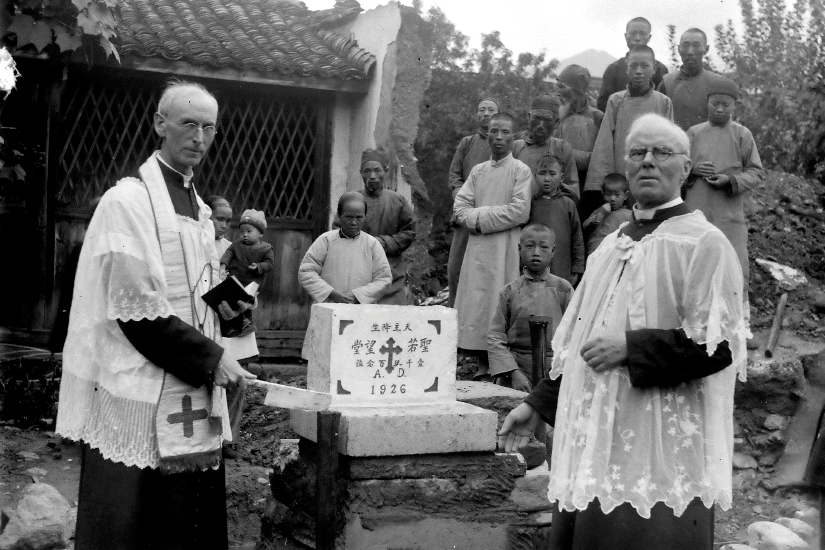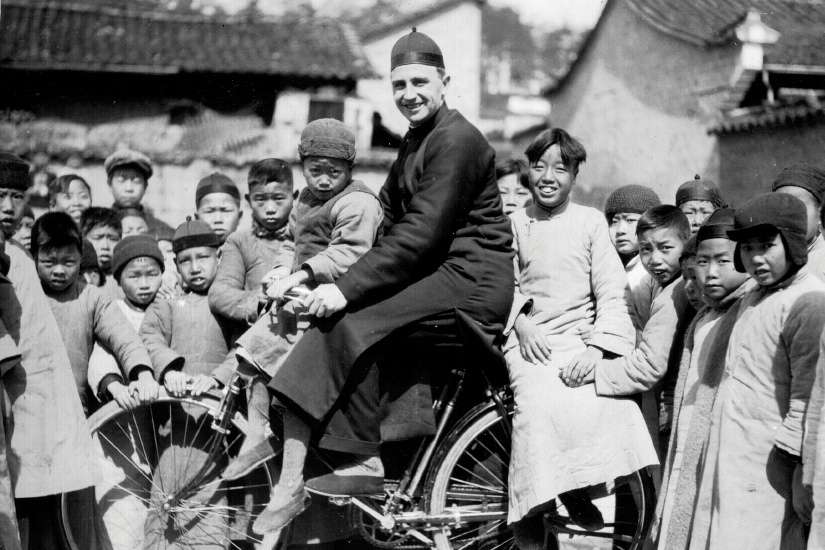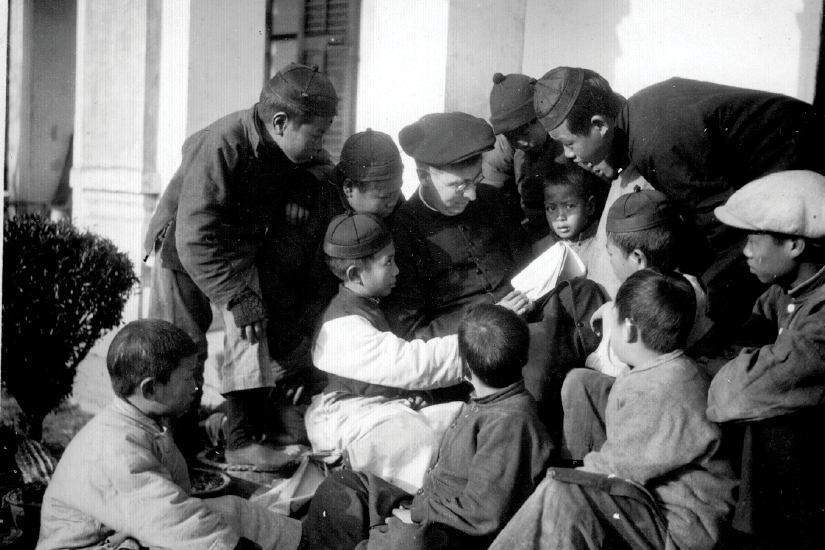 “I do not mourn. I rejoice at the blessings that we have been entrusted with,” MacDonell told The Catholic Register in an e-mail.
“I do not mourn. I rejoice at the blessings that we have been entrusted with,” MacDonell told The Catholic Register in an e-mail.
English Canada’s missionary order will be 100 years old on Nov. 9 and that same week most of the remaining priests of the order will move into Presentation Manor, a mixed community of lay and religious retirees.
“I look back at 100 years and I feel very good,” said Scarboro Missions moderator Fr. Jack Lynch. “I’m very proud of our guys, what they did.”
The Scarboros decided in 2017 that even if anybody came looking to join their missionary enterprise they would direct them elsewhere. A community of men in their 70s and 80s is in no position to form young men for priesthood and mission. But it had been years since any vocations had come knocking.
“We’ve always been there to promote the local Church wherever we’ve been,” said Lynch.
In Guyana, Japan, the Philippines, Brazil, Malawi, China and the Dominican Republic there are flourishing Churches with vocations and missionaries of their own because the Scarboros were there first. In hope, gratitude and faith, the mission goes on — not here, but over there.
How?
Lynch’s best illustration is the death of Fr. Lou Quinn — better known in the Dominican Republic as Padre Luis. For two generations if anyone wanted to get elected in the DR, they had to get their picture taken with Padre Luis. The politicians knew the people didn’t trust them, but they trusted the Canadian priest who gave tennis balls to barefoot boys to play baseball and sent a grader out to isolated communities to carve roads out of the hillsides when the government wouldn’t. Padre Luis started the credit union, found lawyers to defend campesinos against the local coffee baron and told young people they had a right to an education.
When Quinn died in 2007, flags flew at half mast across the Dominican Republic. It was a national day of mourning for the man the Dominican government had declared “Father Protector of Ocoa” in 2002. But one of the local Canadian missionaries told Lynch she had actually seen the mantle pass from Quinn to the local Church.
As the old priest was dying, they called in a young Dominican priest to administer last rites.
“At the end of it, (the young priest) asked for Louie’s blessing,” Lynch said. “Louie didn’t have much strength, but the guy got down, put his head down on Louie’s chest. And Louie did give the guy his blessing. He died about 20 minutes later.”
For 42 years, Quinn had embodied what a priest should be for young Dominicans. As the Church in the Dominican Republic slowly built up parishes, a seminary and the capacity to aid and defend their own people, the Scarboros had been there with them. The young priest Quinn blessed represents a vast legacy to the people of God in the Dominican Republic.
The Scarboros had been in country since 1943, well before communist forces took over China in 1949 and began tossing out foreign missionaries in 1951.
 Scarboro Missions founder Fr. John Mary Fraser, left, and his brother Fr. William Fraser pose with parishioners and the cornerstone of a new church for the Piwu Ka Parish in China in 1926. John Mary Fraser first went to China in 1902.
Scarboro Missions founder Fr. John Mary Fraser, left, and his brother Fr. William Fraser pose with parishioners and the cornerstone of a new church for the Piwu Ka Parish in China in 1926. John Mary Fraser first went to China in 1902.
 Fr. Craig Strang on his bicycle is given plenty of attention from his pupils in the 1930s.
Fr. Craig Strang on his bicycle is given plenty of attention from his pupils in the 1930s.
 Msgr. William McGrath is given plenty of help in 1932 as he learns to teach Chinese. With the communist takeover of China in 1949, the missionaries were eventually expelled from China, but had already begun missions in other countries. (Photos courtesy Scarboro Foreign Mission Society Archives)
Msgr. William McGrath is given plenty of help in 1932 as he learns to teach Chinese. With the communist takeover of China in 1949, the missionaries were eventually expelled from China, but had already begun missions in other countries. (Photos courtesy Scarboro Foreign Mission Society Archives)
View more photos
There’s a myth that the Scarboros, who started in Almonte, Ont., as the China Missions, only took on the rest of the world as a consolation prize after Mao’s communist government first imprisoned and then expelled the missionaries between 1951 and 1954. In fact, the Scarboros renamed themselves and found work beyond China just as the Second World War got hot in 1940.
That year there were 38 Scarboro priests in China and the number would only decline even as the number of Scarboro priests continued to grow to an all-time high of 161 in 1968. China was becoming less important because the mission beckoned from around the globe as nations began to shake off colonial masters of all sorts.
In 1918, when the Church in English Canada first got around to taking on its missionary responsibilities, China was the obvious target. Canadian Protestant missionaries had already been there 25 years when Msgr. John Mary Fraser went to visit Pope Benedict XV and received a papal blessing on the enterprise.
Fraser was certainly the founder and fundraising genius behind the China Mission Seminary, which soon moved from Almonte to the Scarborough Bluffs east of downtown Toronto. He was the first English Canadian Catholic missionary in China from 1902 to 1910. However the China mission didn’t become a permanent, viable presence until 1925 when Fr. Paul Kam became the first native Chinese to be ordained in Canada then sent to Chekiang (today it would be written Zhejiang).
By the 1930s, Fraser’s go-it-alone, trailblazing style was grating on the society he had created and the bishops in China. He was politely ordered back to Canada to apply his talent and energy to promoting the missions.
Even then the industrial-age, colonial model of mission that Fraser exemplified was beginning to break down. The Scarboros arrived in China ready to baptize, teach and preach — which they did in great numbers — but soon realized that to live among the people they must learn from the people. They must be less their masters and become their friends.
By the time the Second Vatican Council came along, the Scarboros were ready for a new vision of mission.
“God speaks to us, and it’s not just in our culture,” said Lynch. “God is present in every culture. God is present in the people who are not Christian. God is active in history. Our role is to discern how it is that God is acting, what God is calling us to do and to be there at this moment in time.”
This more expansive understanding of mission also translated into an expanded definition of missionary. By 1975 the Scarboros were training and sending out lay missionaries.
Mark Hathaway was a Scarboro lay missioner in Peru from 1982 to 1990. He was an energetic young man organizing the local youth group and helping out with the Christian Workers’ Movement. Though he lived his first three years in the rectory with the priests, he moved out to live with a Peruvian family in Chiclayo. He met his wife in Peru. He took courses taught by the Dominican founder of liberation theology Fr. Gustavo Gutierrez.
He came home to Canada to apply what he had learned, working ecumenically with the Inter-Church Committee on Human Rights in Latin America. He worked with all the churches demanding debt relief in advance of the 2000 Jubilee. Eventually he began collaborating with Brazilian theologian Leonardo Boff, producing the 2009 book The Tao of Liberation.
Today Hathaway is a postdoctoral fellow at the University of Waterloo’s School of Environment, Resources and Sustainability. He traces the origins of his 35 years of work in the Church back to the Scarboro vision of mission. The long goodbye is bittersweet.
“It feels like the end of an era. It is kind of sad,” he said. “There is a legacy. It’s not like all the good work ends here. It’s kind of rippling out in many places throughout the world.”
In September, MacDonell was bouncing along the road to Pedra Branca in a truck through 35-degree heat. He arrived in the mountain village with copies of a children’s Bible written in Makushi to help the village through a language course — a course village leaders declared was a campaign. “Our first struggle was for our land. Now the next struggle is for our language and culture,” the chiefs declared.
He celebrated Mass with the people, then applied his expertise as a linguist, not so much in teaching Makushi as in helping the elders communicate with a generation that is growing up with Brazilian TV and the Internet.
At the end of the course, the elders called Padre Ronaldo into the middle of the village circle to receive “the spirit of Makunaimi,” an ancient Makushi hero. Boys beat leaves on the floor of the community centre to make the sound of the wind which would mark the arrival of Makunaimi’s spirit. As the wind died down the community danced around the Canadian priest. Speeches were made, mostly in Makushi.
This is missionary work, to give people back what was theirs — their communion with one another and with God in the language and culture of their birthright.
“Yes, I am content. Yes, there is consolation,” MacDonell told The Catholic Register. “Scarboro Missions exists not for itself but to serve the Kingdom of God, proclaimed by Jesus. SFM (Scarboro Foreign Missions) lives on in all the people touched by SFMers over the past 100 years, and in our own hearts — touched by the same people in so many lands.”

